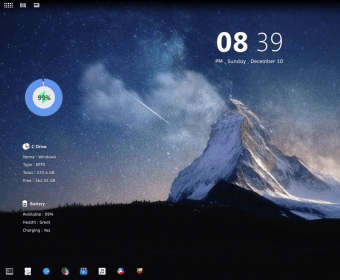
If tired of your Windows OS look-and-feel, or if you simply don’t like Microsoft’s desktop design for their latest versions of Windows, Octoroit Virtual OS offers you a much more attractive alternative. Complete with its own set of apps, widgets, and system management options, this free utility will give your OS desktop and windows a smoother and professional-looking new interface.
Octoroit Virtual OS is not a different operating system that will wipe out your Windows OS – it is just a new and different way of interacting with it. It is not a substitute for your Microsoft OS, even though it does include some tools and applications that make a number of Windows apps redundant. It feels like working with a different OS altogether, but it is, in fact, your original version of Windows that keeps managing your system in the background. So, why to install Octoroit Virtual OS? Well, not only it is much more attractive than any Windows OS you might have worked with, but it is also more user-aware. It has been designed to provide you with a wider and cleaner workspace, with smaller icons neatly placed in areas that won’t take up your valuable desktop space, and it comes with a set of media-related and system management tools that will make some of you forget about Windows.
Or not quite. Octoroit Virtual OS takes over your operating system completely, which means that no app you had installed on your system will be reachable while this virtual OS is active. There is no toggle-on-and-off switch that allows you to go back to Windows in a snap in case you need to work with a tool for which Octoroit has no substitute. Thus, if the 25+ apps that come with Octoroit are not enough to replace the Windows programs you usually work with, you will need to log off this virtual OS, go back to your old Windows desktop, and log in again once you’ve finished. It is like switching your computer on and off every time you open a new app.
The apps provided are not all apps, actually – some of them are but links to Internet sites, such as Wikipedia, Facebook, Twitter, or Amazon. Among the true new apps that the program provides, you’ll find a note taker, an e-mail client, a video player, an audio player, an image editor, an Internet browser (Tron), a password generator, Security Guard, and even its own programming language (NEO) to create basic new routines. Note that to make the most of this virtual OS you’ll need to allow for some learning time in order to familiarize yourself with the new icons, the position of the “Close” button in the new windows (usually on the upper left corner), and the new menus.
Moving around its interface is certainly much more pleasurable than roaming around your Windows desktop. However, the decision to switch to Octoroit will largely depend on the use you make of your computer. If you mainly use it to surf the Web, listen to music and watch videos, edit images and draw new ones, and probably to write a diary or take some simple notes, you’ll find Octoroit to be a great improvement in terms of both usability and aesthetics. Those using their PC for other not-so-ludic tasks will find this virtual OS fairly limiting.
Comments (1)